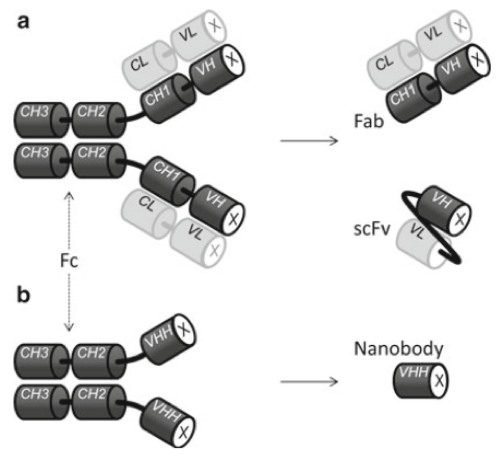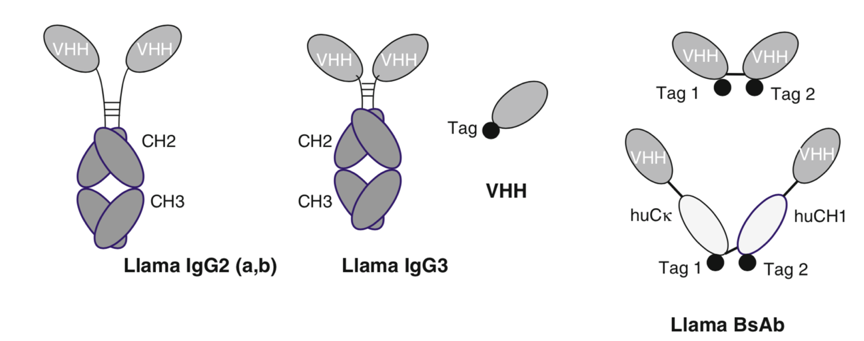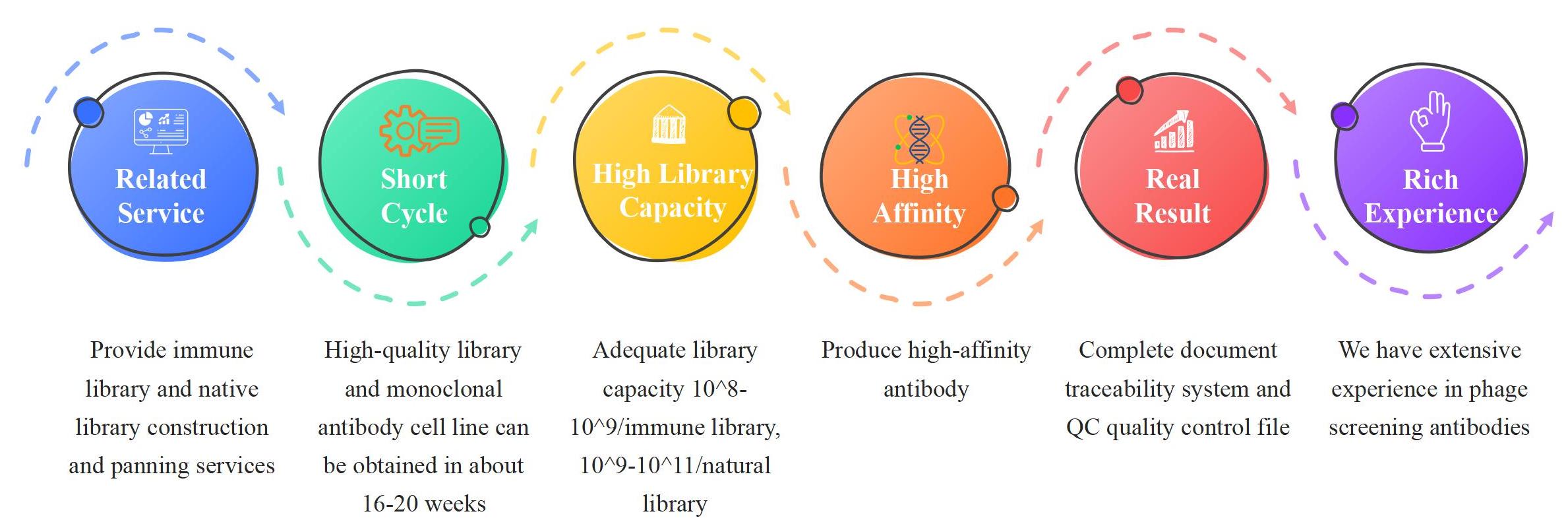Service Line:+86-022-82164980
Address:FL-4, Building A5, International Enterprise Community, Tianjin, China
Email:[email protected]
KMD Bioscience's proprietary antibody phage display screening method allows efficient, high throughput identification for a specific application. M13 phage display-based camel antibody screening services, including Bactrian camel and dromedary (alpaca)-derived nanobody phage display technology services. With our scientists' expertise in heavy chain antibody (VHH antibody) library display construction and screening, we target high-quality nanobodies, and ensure optimal efficiency for our customers. KMD Bioscience is a leading provider of camel-derived VHH antibody phage display library construction service. Our goal is to support our customers in their research, diagnostics, and therapeutic development endeavors by providing them with superior VHH antibody libraries construction and screening.
Camelid antibody production refers to the process of generating antibodies from camelid species, specifically camels, llamas, and alpacas. These animals naturally produce unique antibodies known as heavy-chain-only antibodies or HCAbs. HCAbs consist of a single heavy chain, devoid of the typical light chain found in conventional antibodies. Within the heavy chain, a variable domain called VHH or nanobody contains the antigen-binding region.
Camelid VHH Antibody Library Service-Heavy Chain Antibody Background
There are four IgG subclasses (IgG1, 2, 3, and 4) in traditional serum antibodies, but only three IgG subclasses (IgG1, 2, 3) in camelid. The structure of camelid IgG1 is similar to traditional IgG: two heavy chains and two light chains; IgG2 and IgG3 lack the CH1 and light chain domains and are therefore also referred to as heavy-chain antibodies (hcAb), as shown in Figure 1.

Figure 1 Classical antibody and heavy chain antibody structure
*(a) Conventional antibodies and their Fab/scFv antibody forms (b) Heavy-chain antibodies and their VHH antibody forms
The distribution of heavy-chain antibodies in alpaca and camel serum is uneven. The ratio of heavy chain antibodies in camel serum antibodies is about 60-75%, and the proportion of heavy chain antibodies in alpaca serum antibodies is approximately 40-50%. This significant difference led to the innate advantages of the constructed camel VHH antibody library, as shown in Table 1. The camel source antibody library mainly refers to a VHH antibody library constructed by using the variable region of a camel-derived heavy chain antibody, a VHH region sequence, which is also called a nanoantibody library. The VHH antibody is characterized by an antigen-binding region containing only the heavy chain antibody. As shown in Fig. 2, the amino acid length is about 110 AA, and the SDS-PAGE shows a molecular weight of about 15 kDa (much smaller than the molecular weight of the conventional antibody 150 kDa) and has excellent stability. It is resistant to extreme pH environments. Meanwhile, VHH antibodies also have good adaptability, and it is easy to meet the requirements of transformation and sorting experiments of immune cells such as CAR-T.

Fig. 2 Alpaca heavy chain antibody and VHH antibody
Comparison of Camel and Alpaca VHH Antibody Library
|
Content |
Camel VHH Antibody Library |
Alpaca VHH Antibody Library |
|
Antigenic Tolerance |
High, multiple antigens mixture, high doze immunization |
Relatively high, multiple antigens mixture, medium doze immunization |
|
Antiserum Titer |
High |
High |
|
Neutralizing Antibody Titer |
High |
Relatively high |
|
Antibody Affinity |
Easier to obtain high affinity antibodies |
Able to obtain high affinity antibodies |
|
Antigen Amount |
4-6mg, purity>85% |
2-3mg, purity >85% |
|
Blood Amount |
~100ml |
~20ml |
|
PBMC Cell Amount |
High |
Common |
|
Library Capacity |
High, Immune library 10^8-10^9 |
High, Immune library 10^7-10^8 |
|
Cost of Immunization |
Relatively low |
High |
|
Small Molecule Antigen Reactivity |
High |
Common |
Camelid VHH Antibody Library Service -Camel VHH Antibody Library Construction Service
KMD Bioscience provides high-quality, camel derived VHH antibody phage display library construction services. We insist on using the QbD (Quality by Design) design principles of human vaccines and biopharmaceuticals and on the basis of understanding and respecting ICH principles, design and camel VHH phage antibody library generation to provide customers with a complete product traceability system and documentation support system. Phage antibody library generation includes antigen design, animal immunization, library construction and screening.
Antigen Design of VHH Antibody Phage Display Library
For camelid antibody production service, we designed a series of human immune checkpoint proteins from the fusion expression of camelid antibody Fc fragment. Combined with our mature Freestyle 293F and Expi CHO cell suspension expression platform, we can provide gene expression, vector construction and gram-level protein expression in a short period of time. For potential service needs, please consult our protein expression platform. At the same time, based on our experimental results, we found that the immune effect of small molecule protein directly immunized with the human Fc fragment is much better than the target protein fusion alpaca or camel Fc fragment (Please contact our technical support if you are interested in our service).
Animal Immunization of VHH Antibody Phage Display Library
KMD Bioscience provides an unimmunized, age-old (28-36-month-old) camel or alpaca for antigen immunization through collaboration with camel and alpaca farming communities. According to standard immunization methods, 4-7 needles are immunized. According to the ELISA serum titer, the protein antigen was >105 standard, and the small molecule antigen immunization ELISA serum titer was >10^4.
Library Construction and Screening of VHH Antibody Phage Display Library
KMD Bioscience harnesses the pIII protein of the M13 phage as the cornerstone for VHH antibody (nanobody) surface display, ensuring robust and efficient presentation of target-specific antibodies. Our dedicated team of scientists has meticulously crafted a phage vector equipped with Flag and 6*His tag double tags, enhancing the recognition and purification capabilities of the resulting antibodies. In tandem, our proprietary TG1 and XL1-Blue host competent cells boast an impressive transfection efficiency of 10^8, ensuring optimal expression and display of the VHH antibody library. Through a streamlined process involving 2-3 transfections and subsequent amplification steps, we proudly deliver high-quality VHH antibody display libraries with ample capacity ranging from 10^8 to 10^9, alongside packaging capabilities reaching 10^13-10^16/ml. Furthermore, our innovative approach to nanobody library screening employs antigen-limited pressure screening, facilitating the isolation of 20-30 high-affinity phage strains following just three rounds of screening. This efficient methodology ensures rapid identification of potent antibodies tailored to meet specific research objectives. With a simple induction protocol using IPTG, our clients can swiftly access a vast array of antibody expression products within a mere 1-2 weeks. These products are readily amenable to diverse research applications, including Fluorescence-Activated Cell Sorting (FACS) and cell activity testing, empowering researchers with the tools they need to advance their scientific inquiries with confidence.
Nanobody Production Service Process

VHH Antibody Library Construction Service Workflow
|
Steps |
Specification |
Timeline |
Deliverables |
|
Step1: Animal Immunization |
* A healthy, full-aged Bactrian camel (28-36 months old) * Serum titers were measured by ELISA and collected peripheral blood. |
6-8 weeks |
* Experimental report: including detailed construction procedures and representative sequence information. * VHH antibody library 2ml, >1⨯10^13 /ml phage particles * 10-15 positive clones were expressed to prepare VHH antibody supernatant. * 10-15 expressing strains of positive clone. |
|
Step2: cDNA synthesis (Clients can provide cells) |
* Total RNA extraction. * PCR amplification with Actin-specific primers to identify the quality of cDNA. |
3-4 weeks |
|
|
Step3: Phage Antibody Library construction |
* Primer design & synthesis. * PCR amplification of variable region genes of heavy and light chains using cDNA as a template. * scFv gene splicing. * Plasmid construction & transformation: after enzyme digestion, scFv and phagemid vector were ligated and transformed into TG1 host bacteria by an electric shock to construct antibody libraries. * Identification: 20-50 clones were randomly selected, PCR identification, sequencing and analysis of antibody sequences. * Packaging: >1×10^13 phage particles /ml. |
||
|
Step4: Phage Antibody Library Screening (3 Rounds) |
* The antigenic limit pressure method is used for 3 rounds of panning * Identification: 96 clones were randomly selected for ELISA titer determination * Up to 96 positive clones were sequenced, and the 10-15 clones were selected for prokaryotic expression transformation. * 10-15 positive clones were expressed to construct the VHH antibody supernatant. |
3-4 weeks |
|
Note: 1. If the client provides camel peripheral blood lymphocytes, lymph node cells or spleen cells (preserved in RNA later and other solutions to avoid RNA degradation, blue ice transport), the service can start from the second step to construct the VHH antibody library, only 3-4 weeks are needed.
2. Cell lysates were prepared using Trizol solution and transported on dry ice.
VHH Antibody Library Construction Service Highlights

How to Order?

If you have any questions regarding our services or products, please feel free to contact us by E-mail: [email protected] or Tel: +86-400-621-6806